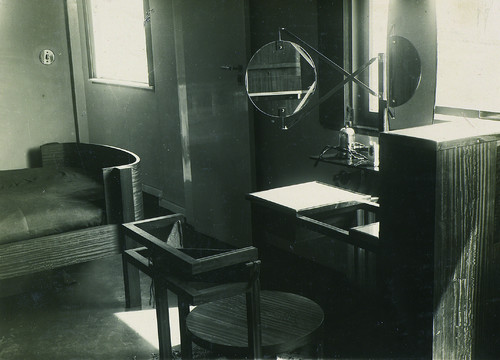Germany’s Weimar Republic lasted only 14 years, yet produced immense creativity and intellectual achievement. And in my latest article, published at MaxEternity.com, I interviewed Eric Weitz, Dean of Humanities and Arts and Distinguished Professor of History at The City College of New York. Weitz is also the author of Weimar Germany: Promise and Tragedy, and in our conversation we talked about global politics—how much of it mirrors Germany’s Weimar Republic, especially in the US—and we talked, as well, about how the Weimar Republic launched the [Bauhaus] birth of modernism. Describing what the Weimar Republic was like, Weitz says it’s an “interesting, strange juxtaposition of both crisis and artistic creativity, and I think they are related…the fragility of the economy and the political system inspired artists to innovate.” Read more.
Showing posts with label Bauhaus. Show all posts
Showing posts with label Bauhaus. Show all posts
Wednesday, June 15, 2016
Tuesday, June 7, 2016
Andrew Reach on From Bauhaus | To Black Mountain
“I think you are writing a very important book on the subject of the Bauhaus and Black Mountain College—in a way not touched in academia, as far as I know—inclusive to the interconnections with the Jim Crow South, and shedding light on new territory about African American modernists. I think also your perspective is fresh, in comparison to the usual suspects in mainstream academia who have dominated the subject. On a side note, the cover art you created for this project is beautiful, and connects with the modernity of the Bauhaus and Black Mountain College.”
Andrew Reach
Architect | Artist
Wednesday, May 18, 2016
Haus am Horn: The First House Built by Bauhaus School @ Houzz
Zimmerman writes:
All the Bauhaus workshops helped build and furnish the house, which emerged as a residential prototype.
It was supposed to be the beginning of a Bauhaus village that would be like a university campus today. However, after the state elections of 1924, the power structure in Thuringia changed, and the new conservative administration cut the school’s budget by half. In 1925, the Bauhaus moved to Dessau, and the village did not come to fruition.
Zimmerman acquired an excellent selection of photos for the piece, which includes images of early furniture designs by Marcel Breuer. And curiously, although many architects came and went at the Bauhaus, the Haus am Horn was actually designed by an artist, named Georg Muche.
By Eva Zimmermann - See more Home Design Photos
Interviewed for the article is Michael Siebenbrodt, the director of the Haus am Horn and curator of the Bauhaus Museum, and it's fair to say that overall Zimmerman has really done her homework for the piece, which I recommend reading for anyone truly interested in the origins of modernism. The article is found here.
Sunday, April 17, 2016
David Ryan gives a succinct 2-minute talk about the Bauhaus
From a 1999 video, David Ryan, who was at the time a curator at the Minneapolis Art Institute, give a succinct 2-minute talk about the Bauhaus. Naturally, Ryan talks about Germany, but like so many other historians, he mentions the Bauhaus post-war migration to Chicago, but fails to mention Black Mountain College in Asheville, North Carolina.
Saturday, March 5, 2016
Oskar Schlemmer’s Triadisches Ballet
Oskar Schlemmer’s Triadisches Ballet (Triadic Ballet) is a modern movement performance in three parts. Created in 1922, the geometrically composed and choreographed dancers of the Triadisches Ballet move in spatial relation to a trinity of costume, dance and music.
An interdisciplinary artist since childhood, in 1920, Schlemmer was invited by Bauhaus founder, Walter Gropius, to head the sculpture and stage workshops at the Bauhaus, then located in Weimar, Germany
He had a unique and very distinguished career that saw many notable achievements. And in many respects Schlemmer opitimized "Gesamtkunstwerk" in that he was one of the most versatile artists of the 20th century, creating costumes, murals, sculptures, drawings and paintings, as well as being a highly-effective educator.
Subscribe to:
Posts (Atom)


